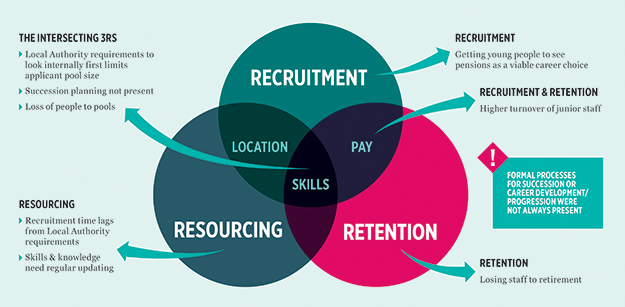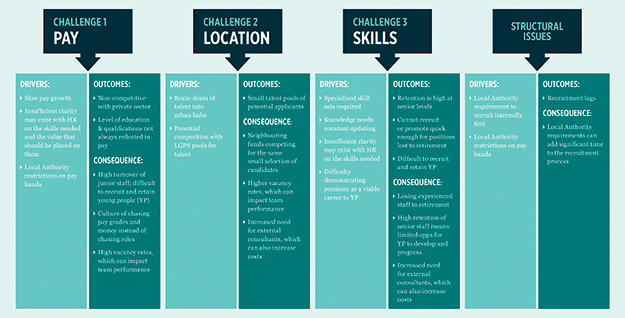Nuturing careers in the LGPS

|
Written By: Tiffany Tsang |
With Local Authority pension funds facing pressure on recruitment, retention and resourcing, the Pensions and Lifetime Savings Association has been exploring best practice for talent management in the LGPS
With 5.6 million members and assets totalling £263 billion, the Local Government Pension Scheme (LGPS) is one of the largest Defined Benefit (DB) schemes in the world and is the largest DB scheme in England and Wales. Given its prominence in the retirement outcomes for so many people, it becomes especially important to pay attention to the drivers of talent management challenges facing the LGPS, to ensure that funds have the quality and diversity of skills it needs, as well as the right number of people on the ground, to maintain an efficiently run and well performing pension scheme.
The PLSA’s LGPS membership flagged to us the growing pressure on recruitment, retention and resourcing (the three Rs) and asked for our guidance to help both explain and address these tensions. In August, we launched our Talent Management in the LGPS: the three Rs, which seeks to understand – through survey work and qualitative interviews with LGPS funds and a few comparable private sector schemes – the root causes of the common challenges facing the LGPS. The report consolidates the experiences of those involved in leading administrating authorities by including examples of proactive remedies already in place, which may be of interest to all LGPS stakeholders.
Why is there pressure on LGPS talent management?
The LGPS has been undergoing a period of substantial change for nearly a decade – the largest of these being the advent of the LGPS investment pools for England and Wales. However, there have been other significant policy developments that provide additional context to explain the increased pressure on the three Rs. These include pay freezes and other austerity measures introduced since the Great Recession; transitioning to a Career Average Revalued Earnings (CARE) scheme in 2014 (England and Wales) and 2015 (Scotland and Northern Ireland); and a whopping 50% increase in the number of employers joining the LGPS between March 2013 and March 2017.
It is also important to note that the LGPS is a statutory scheme, not a trust scheme, and therefore the governance and management structure of LGPS funds are unique. The complex relationship between LGPS funds and their local authority is both the source and potential solution to some of the talent management challenges identified in our study.
The challenges
Within recruitment, retention and resourcing, the challenges are often linked and overlap in intricate ways. The most significant relationships are with pay, location and skills.
The LGPS faces fierce competition with the private sector on pay for talented staff. Slow pay growth in local government and rigid pay bands make compensation packages restrictive. As pensions is also often very different to other aspects of the Local Authority’s work, it can mean that “pricing” roles correctly for LGPS funds is not an easy or straight forward task for Human Resources. Non-competitive pay results in high turnover of junior staff; overall difficulties in attracting young people to the profession; and Local Authorities finding it difficult to fill vacancies quickly, ultimately impacting resourcing and potentially hindering service delivery.
Some funds did indicate a high level of existing independence from their Local Authority, affording them a certain level of flexibility and autonomy in recruitment and resourcing. Whether a more consistent application of independence across LGPS funds from local authorities would assist with some of the three Rs’ challenges may be an area worth exploring.
Figure 1: Overview of the complex talent management challenges facing LGPS

Source: PLSA
Location is another factor which impacts recruitment and resourcing. In many ways, it’s difficult for funds to win as they can either be too far from urban hubs, where highly skilled people tend to migrate into, or they are too close to other LGPS funds and investment pools, resulting in additional levels of competition for an already limited group of potential candidates.
The requirement for specialist skills cuts across all three Rs. A wide spectrum of expertise is often required, including pension and investment management experience, regulatory knowledge, and accountancy skills. Finding someone who ticks all the boxes, getting them to join, and then holding on to them in the face of the challenges outlined above, can feel like a mammoth task. Paradoxically, the high junior staff turnover is in part due to the high retention of senior staff over time. While retention is overall a strength, it is problematic here for two reasons. There is limited space in the current fund structures for career progression, and, when funds lose senior managers to retirement, the funds are unable to replenish ranks at all levels fast enough. It takes time to build up the relevant skills, which is hard to do if younger recruits are not incentivised to stick around.
The successes
Our guide, which is available to all of the PLSA’s LGPS membership, dives deep into the proactive remedies already in place to tackle the challenges highlighted above. These best practice solutions include, for instance, using apprentices and students during summer holidays to create a pipeline of talent; career evenings and career fairs; interviewing for soft skills as well as hard skills; and systematic training for both junior and senior staff.
The PLSA’s talent management guide also provides an in-depth analysis of the potential levers for change (Figure 2, on the previous page). The outcomes and consequences listed in Figure 2 can be thought of as symptoms of the talent management challenges. The drivers are the underlying conditions or factors that cause the symptoms to appear. The examples of best practice discussed in our guide address some of the drivers listed below.
Figure 2: Drivers of LGPS talent management challenges

Source: PLSA
It is important to note that our research found important strengths in the current local authorities’ approaches, including that the turnover rate is lower than the national average and that retention over time of senior staff is high. This shows that initial recruitment for roles is capturing the right skills. But, fund vacancy rates, which are higher than the national average, point to the need to widen applicant pools and to encourage a speedier hiring process.
Our research with private sector schemes of comparable sizes also indicates they face very similar challenges to LGPS funds and employ similar remedies. However, one response to challenges that many LGPS funds cannot yet utilise is the speed of the private sectors’ reaction time to remuneration, as LGPS funds must adhere to paybands set by their Local Authority.
Expanding on the possible remedies
A common theme throughout the analysis is that recruiting and retaining young people is difficult for careers in pensions in LGPS funds. This is particularly important for long-term resourcing, especially when a cohort of expert knowledge is increasingly lost to retirement. This issue is not unique to the LGPS, but it highlights the importance of finding new way to engage and attract younger people into a career in pensions.
Widening the applicant pool more generally is a key area explored in the guide’s policy implications. For instance, we look at how language can be reframed in describing a career in pensions. Characterising a pensions job as one within an organisation that manages a multibillion-pound fund might be more appealing to a larger range of individuals, and not just to those who have pre-existing technical pensions expertise. Formalising processes for career development, regularly monitoring staff experiences and working more closely with local authority HR are other important areas explored.
Talent management in the LGPS: what now?
There are still knowledge gaps in tackling the talent management puzzle. Some areas, such as the impact of LGPS investment pooling and the rise in the number of employers, will require a measure of time before any consequences can be fully understood. Some other gaps are additional questions that need to be addressed. For instance, more work is needed to understand granular drivers for retention – why people stay, why people leave, and whether there is anything concrete that can be done about these factors. Are flexible working hours and working from home most prized? Or is it the openness to maternity leave? Is it work-life balance? Is it more men or women who opt to stay for longer periods?
We will continue to work with our Local Authority members and partners in local government to monitor and tackle these talent management issues together.
More Related Content...
|
|
|